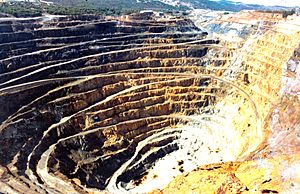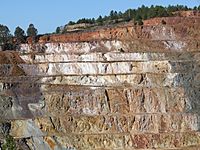Corta Atalaya facts for kids
Corta Atalaya is a giant hole in the ground that used to be a huge mine! It's the biggest open-pit mine in Europe, and for a while, it was the largest in the whole world. An open-pit mine is like a giant quarry where minerals are dug up from the surface, rather than from tunnels underground. This amazing mine is located in Minas de Riotinto, a town in the Province of Huelva, Andalusia, Spain.
The mine is shaped a bit like an oval. It's about 1,200 metres (3,900 ft) long, 900 metres (3,000 ft) wide, and 350 metres (1,150 ft) deep. That's like stacking over 100 tall buildings on top of each other! The company that owned it, the Rio Tinto Group, started this huge project. When it was busiest, about 2,000 people worked there, digging for copper. The mine was actively used until 1992. Since 1994, parts of it have been filled with water.
Work on this open-pit mine began in 1907. It started because the ground above some older underground mines had sunk. This happened because some of the rocks, called pyrites, caught fire deep inside the earth. The mines were taken over by the government in 1954 but were later sold back to a private company. As of 2009, a company called EMED Tartessus planned to start mining there again.
Contents
What is Corta Atalaya?
Corta Atalaya is a special type of mine located in an area called the Iberian Pyrite Belt. This area is known for having many valuable minerals. The rocks here were formed a very long time ago, between 443 and 299 million years ago. They contain important metals like copper, zinc, lead, gold, and silver.
The Village of La Atalaya
There used to be a village called La Atalaya right next to the mine. It was built for the miners who worked in the underground tunnels of the San Dionisio area. When the Corta Atalaya open-pit mine started in 1907, the village became home to those miners instead.
In 1873, the Rio Tinto Company bought the mines. They needed a way for miners to live closer to their jobs. So, they decided to build houses where the miners had already set up simple huts. The village of La Atalaya was officially started in 1883. The company built 100 small houses, each about 45 square metres (480 sq ft), to give the miners a basic place to live.
The company also built a town square, a chapel, a grocery store, a casino, a school, and even a police station for the Guardia Civil. For almost 100 years, this village was home to many miners. The number of people living there was highest around 1910:
| Year | 1888 | 1900 | 1910 | 1920 | 1930 | 1940 | 1950 |
|---|---|---|---|---|---|---|---|
| Population | 823 | 1,272 | 1,472 | 1,105 | 1,238 | 1,009 | 662 |
By 1970, La Atalaya had 257 buildings and 823 people. But that year, the mining company got permission to make the mine even bigger. So, in 1971, the village of La Atalaya had to be destroyed because it was in the way of the expanding mine. La Atalaya wasn't the only town moved for the mine; the original town of Minas de Riotinto was also moved to its current spot.
After the Mine Closed
After the mine closed in 1992, it was possible for people to visit it for a while. However, by 2007, the new owners, EMED Mining, stopped public visits. They were thinking about allowing visitors again in the future.
EMED Mining hopes to restart the mine. They believe it could create 450 jobs and bring over €130 million (about $140 million US dollars) into Spain each year. By 2007, they had already spent €3.5 million (about $3.8 million US dollars) on cleaning up the mine and getting it ready to reopen. They planned to spend another €15 million (about $16 million US dollars). In 2009, they hoped to start digging again by the end of 2010.
The old mine has even been used as a filming location for movies!
- El corazón de la tierra (The Heart of the Earth) is a historical film about the Rio Tinto mines.
- Proxima is a science fiction movie that used the mine's unique landscape to look like another planet.
There's also a nearby golf course called Club de Golf Atalaya. It only has grass on the putting greens, which are the smooth areas where golfers try to get the ball into the hole. This golf course was originally founded in 1890, making it the oldest in Spain! It was abandoned for a while because of the growing Corta Atalaya pit, but it reopened in 1992.
Images for kids
These pictures help you understand just how huge the mine is!
-
Zooming in further, one can see that the object is an abandoned steam locomotive. (Click through for a larger image.)
See also
 In Spanish: Corta Atalaya para niños
In Spanish: Corta Atalaya para niños







